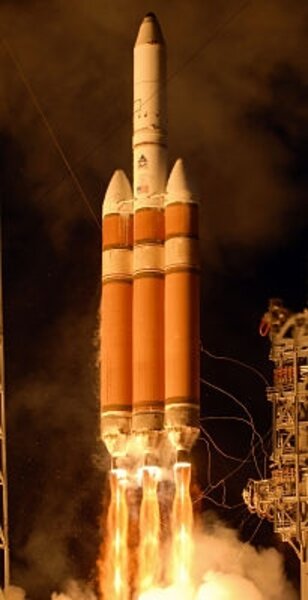As rocket launches increase, ozone layer could feel the heat
Loading...
Just when it looks as though people could breath a sigh of relief over the hole in stratospheric ozone over Antarctica -- it's expected to heal by 2050 -- scientists are raising a new ozone-related concern: rocket launches.
That's right. Rocket launches.
The idea is not as wiggy as it may sound. As early as 1974, some scientists had noted that the space shuttle -- still a gleam in NASA's eye at the time -- would be a source of chlorine emissions as it climbed through the atmosphere and passed through the stratosphere.
Chlorine-based compounds called chlorflorocarbons have been the main driver behind the loss of ozone in a high-altitude layer of the atmosphere called the stratosphere. They've been banned via the 1987 Montreal Protocol, along with other ozone-trashing compounds.
Indeed, some people have argued -- wrongly -- that the space shuttles have been responsible for the ozone hole.
For a team led by Martin Ross at the Aerospace Corporation in Los Angeles, it's not a question of today's launches being a problem. In a new research paper that appears in the on-line issue of the journal Astropolitics, he and his colleagues note that today's launch and reentry emissions are far too small to have a significant effect.
Down the road, however, the picture could change, especially if aerospace-industry launch projections pan out.
The team's pitch: Don't wait until then to figure out if this will be an issue. That could lead to a mishmash of regulations that could choke off the launch business. Instead, gather the data now in a rigorous, transparent way so that if emissions regulations are required in the future, they won't be cobbled together at the last minute with little scientific basis for designing them.
"Currently we've got launch activity that's really ramping up," says Darian Toohey, an atmospheric chemist at the University of Colorado at Boulder and a member of the research team. Projections that aerospace companies are trotting out in Powerpoint slides at industry meetings point to a launch rate by 2030 or 2040 that is three to 10 times higher than it is today.
At the same time, scientists' ability to gather and analyze samples from rocket exhaust plumes has improved dramatically, giving them an ability to more-thoroughly study the issue. Some of that sampling already has taken place, thanks to NASA's cooperation, Dr. Toohey says during a phone chat.
That's given the team an opportunity to take an initial crack at estimating what sort of effect higher launch rates could have on stratospheric ozone.
Initial estimates...
No surprise, but depending on worldwide launch rates, heft of the payloads, fuels used, and other factors, a decline in ozone loss reverses around 2028 and loss begins to skyrocket if countries triple their launch rates every 10 years. The increase in ozone loss comes later and destruction rises somewhat less rapidly if launch rates only double every 10 years.
What makes rocket motors so special? The team identifies three items: They inject the ozone assassins directly into the stratosphere, where the culprits remain for years; the released of relatively small amounts of ozone-depleting compounds can trigger significant changes to ozone levels; and motors not only deliver reactive gases that destroy ozone, but they also are sources of tiny solid particles on which the chemical reactions take place. The particles also live long and prosper at stratospheric altitudes.
Indeed, Toohey says air samples from the stratosphere have turned up tiny particles of alloys that can be traced directly to space-shuttle components, as well as tiny particles of aluminum from the fuel mixture that fills the orbiters' solid-rocket boosters.
..but they're rough
The team acknowledges that their estimates on the potential ozone loss is rough. Uncertainties riddle the approach the researchers used to make their calculations. But those uncertainties can cut two ways -- reducing the issue to trivial, or pushing it to the head of the class.
Toohey notes that the study is designed to start the conversation, not end it.
But the assumption that may have seemed reasonable in the 1970s and 1980s -- that rocket emissions are an insignificant source of ozone-depleting compounds -- shouldn't be expected to hold up in the future. More countries are becoming space-faring nations, space tourism is expected to expand, and new generations of rockets are expected to cut the cost of launching payloads and people into orbit.
The US once ponied up millions of dollars to study the environmental effects if hundreds of high-flying supersonic-transport airliners took to the skies. The number of SST airliners never topped 20. Here, the team argues, the rocket fleet is real, clearly growing, and yet few are taking as serious a look at the environmental effects from rocket emissions -- a task that could be accomplished far less cost.





